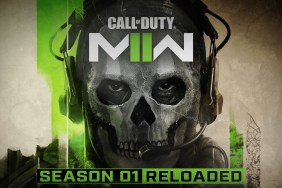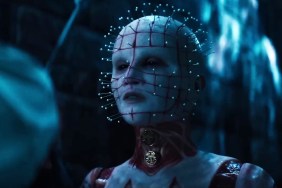Dimensional Analysis.
Oh, relax. No, it’s not that kind of dimensional analysis – although Sega’s strange and moody puzzler Crush does, in fact, revolve around complex physical situations that can be tested by experimentation. It’s also among the oddest of the odd: A “puzzle game” that actually has characters, a story, a mood, fresh mechanics…and even a slightly-eerie style that’s all its own. Glory Hallelujah, the still-anemic PSP takes in a lungful of fresh air, and staggers another promising step forward in the Platform Wars.
[image1]Danny—our nervous train-wreck of a protagonist, who’s been hospitalized for insomnia—is simply packed with unresolved mental “issues,” and the more he thinks about sleeping, the more he can’t. Being the lucky sort that he is, he’s found himself a relative wing-nut of a doctor, who uses a radical form of regression therapy called C.R.U.S.H. (Cognitive Regression Utilizing pSychiatric Heuristics). And let’s just say that the good doctor’s acronymic virtuosity is a pretty good indicator of how things are likely to go for our somnambulistic hero.
Each of Crush’s 40 levels takes the form of a surreal, floating construct—a navigable, mental environment that represents some previous stage of Danny’s life. Danny himself walks around these constructs (in a sleepwalking slouch)—these hovering, mazelike cobbles of cubes, walls, platforms, walkways, big ugly mind-cockroaches, oft-maddening spatial challenges, and visual backdrops representing his unconfronted, unpleasant memories.
So no, this isn’t your father’s puzzle-game—unless your father was a modernist architect with a four-session-per-week therapy regimen and a serious drug problem.
[image2]Even properly describing the gameplay is a bit of a challenge (but it’s easy enough to pick up, thanks to a seamless tutorial). Danny sleepwalks on, around and through these suspended cobbles of cubes, walls, steps, walkways and platforms in an effort to collect objects—his “marbles” (get it?), one Memory per level, and the Trophies that he never won as a child (and how touchingly pathetic is that?). The unique mechanical hook is that, at any time, Danny can stomp his foot and “crush” the fully 3D environments down to 2D levels on any axis. Another stomp, and the apparently 2D environments can be “uncrushed”—inflated—back to full 3D space. Watching this video may help.
Players alternate this crush/uncrush mechanic to get around many obstacles: A tall cube blocking your path? Maneuver the camera to look straight down at yourself, “crush” the world to 2-space, and that obstructing cube is now just another flat square you can walk across (from the overhead view). Then, stomp again to “inflate” the world back to 3 dimensions and rotate the camera down and to the side—and you’ve found a hallway on the Z-Axis, boring into the construct. Re-align, rinse, repeat, regress.
Another example: You’re standing on one floating cube and need to get to another that’s too far away to jump—so, you maneuver the camera so that the near and far cubes appear to line up (via forced perspective), crush the environment to 2D and—ta-da!—the formerly-separated cubes now form one continuous side-viewed platform that it’s safe to walk on.
[image3]These are just the simplest examples. Soon, the complexity of the surreal, collapsible architecture is compounded by new types of blocks (passable hollow blocks, insubstantial ghost blocks, moving and ‘fragile’ blocks), iconic ‘Thoughts’ that can change the behavior of the levels, timed challenges (these can be really rough), and environmental items/hazards (such as scuttling cockroaches, ‘Nightmare blocks,’ massive balls and rollers, critical switches, and cogs). In short order, you’ll realize that the key to navigating the increasingly-Escheresque levels—as is sometimes the case with confronting deep personal issues—is literally in how you look at them. Play this baby too much before you go to sleep, and you’re bound to have at least a little strange, 3-D action going on in your dreams.
The game’s visuals are largely simple and a bit cartoonish… but they’re eerie, sometimes nasty-cartoonish: The oversized Nightmare ‘roaches splatter icky goo when you manage to crush them, and there are other so-called ‘objects’ that lie in deceptive wait for Danny—or even walk, when they ought not to walk. As the players advance (regress, actually) from level to level and memory to memory, deeper into Danny’s troubled past, the background art and ambient audio gets dreamier, and more saturated with unstated childhood menace—suggestions of carnival-and-cradle imagery, and the aural giggles of children.
Crush is a puzzle on which somebody has yacked up a 40-ouncer of the surreal action game Psychonauts. The narrative, meanwhile—moved along by animated still-image cutscenes and dark psychological overtones— feels like something out of The Maxx.
Save some rare problems with Danny’s jumps and the viewing of very complex levels do crop up, but they’re few and far between, and they hardly mar the impressive, challenging and marvelously-presented experience. Crush is a beauty of a game, even with its spikes of head-banging difficulty, and a moody little gem for the PSP. It might even keep you up at night.
-
Unique dimension-swapping scheme
-
Stylish, eerie presentation
-
Formidable puzzle design
-
Camera has some “issues” of its own
-
Some hair-tearing difficulty
-
Will mess with your own dreams










